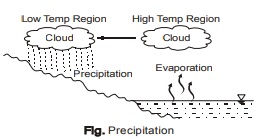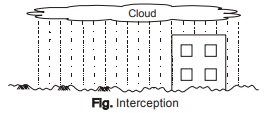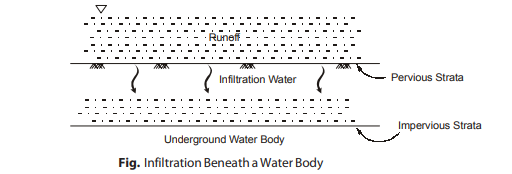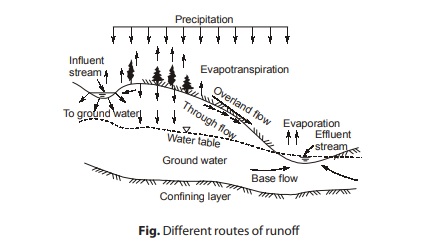What are the major components of the hydrologic cycle?
Various components of hydrologic cycle are as follows:
1. Evaporation: When the water come into contact with heat radiation, it turns into vapour. It is called evaporation.
-
- In hydrologic cycle, evaporation mainly occurs from Ocean. Ocean evaporation contributes in large part and the real evaporation occur from land mass and raindrop evaporation.
- When rain drop comes to the earth surface, and come in contact with sunlight, they also get evaporated in atmosphere.

2. Precipitation: As the evaporation continues, the amount of vapour in atmosphere goes on increasing. After reaching a certain amount, the vapour condense and comes to the earth’s surface in solid or liquid form, this is called precipitation.

3. Interception: Some amount of precipitation is evaporated back to the atmosphere and another part of precipitation is intercepted by vegetation, structure, etc. from where it may be either evaporated back to atmosphere or move down to ground surface.
- Amount of rainfall on the roof building is intercepted rainfall or simply interception.

4. Infiltration: When the water comes in to the earth surface, some portion of it penetrate into the ground and increases the moisture capacity of soil beneath the surface.
-
- This water is called infiltrated water and this process is called infiltration.
- Through infiltration, the water level of underground water bodies increases.
- It is important for underground water movement.
- It will be more in a village in comparison to town, because the town have pacca road which is treated as impervious strata.
- It will be more in forest area in comparison to dessert land because the tree make the surface pervious and increases the infiltration.

5. Transpiration: Vegetation use the ground water or soil moisture for their growth. This moisture again convert into vapour through the process known as transpiration.
-
- Water extracted by plant’s roots, transported upward through its stem and diffused into the atmosphere through tiny openings in the leaves is called transpiration water and the process is called transpiration.

6. Runoff: The portion of precipitation which comes on the surface and reaches the stream channel through above and below the surface of earth is called runoff.
Thus, it means, the draining or flowing off of precipitation from a catchment area through a surface channel.
- The portion of precipitation that reaches the stream after reaching on surface, only from above the surface is called surface runoff.
- The runoff reach in stream channel is called stream flow.

<< Previous | Next >>
Must Read: What is Hydrology in Civil Engineering?

